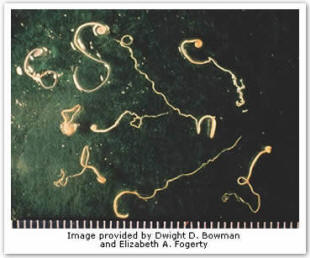
CANINE WHIPWORM

This worm is one of the “big four” intestinal parasites with which our canine friends must contend: roundworms, tapeworms, hookworms, and whipworms.
The whipworm of the dog (Trichuris vulpis) is substantially smaller than the other worms (a mere 30-50 mm in length, about two inches maximum) and is rarely seen as it lives in the cecum (the part of the large intestine where the small and large intestine meet). The “head” (or more accurately the digestive end of the worm) is skinny versus its stout tail (or reproductive end) which gives the worm a whip shape, hence the name.
In the host’s digestive tract, food passes from mouth to esophagus to stomach to small intestine to large intestine to rectum and then to the outside world. This means the large intestine is one of the last stops for nutrients and by this point in the journey, nutrients have largely been broken down and absorbed.
The large intestine (also called the “colon”) serves to absorb water, to store fecal material, and to provide a home for a spectacular number of bacteria which are able to digest the leftover food that we cannot. The large intestine is the home of the whipworm. The adults worms bite the tissue of the intestine, actually embedding their “heads” inside, and suck blood there.
what are the symtoms
The signs of infection vary with the number of worms in the intestine. Small numbers of worms cause no signs, but larger numbers can result in inflammation of the intestinal wall. Large amounts of mucous are produced by the inflamed intestine. Sometimes hemorrhage into the intestine occurs, and anemia can result. Animals may have diarrhea and loss of weight.
In very heavy infections, the worms may penetrate through the intestinal wall and the resulting inflammation causes the intestine to adhere (stick) to the body wall. Animals with this condition may frequently lick their right flank area where the adhesion occurs.
How are whipworms transmitted and how is whipworm infection diagnosed
A dog or cat becomes infected by ingesting food or water contaminated with whipworm eggs. The eggs are swallowed, hatch, and in three months, the larvae mature into adults in the cecum and large intestine where they burrow their mouths into the intestinal wall and feed on blood. Adult worms lay eggs that are passed in the feces. The eggs must remain in the soil for about a month to mature and be capable of causing infection.
An infection is diagnosed by finding the eggs in the feces. The eggs must be differentiated from those of the bladder worm (Capillaria plica) and C. aerophilia, a parasite of the respiratory system, but whose eggs may be found in the feces.
How do we prevent and control whipworm infections

Whipworm eggs are somewhat susceptible to drying, but can remain alive in moist soil for years, and are resistant to freezing. Because of this, animals should be restricted from contaminated areas.
There is no effective method for killing whipworm eggs in the soil. The only alternative is to replace the soil with new soil, gravel, and pavement. To prevent exposure, any feces in the yard should be picked up on a daily basis.
Floors in kennels and dog runs should be impervious so they are easier to clean. Kennels, runs, and litter boxes should be cleaned thoroughly, and if possible, be allowed to dry in direct sunlight.
Routine fecal examinations and wormings can help control this widespread parasite
Because of the zoonotic potential of T. vulpis, care should be taken when cleaning, and people should wear gloves and wash their hands well after these duties.
treatment
Because most canine worm treatment products are not effective against whipworms, extra care must be taken when choosing a dog dewormer for whipworms. Fenbendazole is recommended and is commonly used to control these parasites.
- All About German Shepherd Puppies
- Pet Disease and Allergies
- Hips and Elbows
- German Shepherd Dog Anatomy
- What is Schutzhund
- German Shepherd Behavior
- Quick Tips On German Shepherds
- Our Show Dogs










